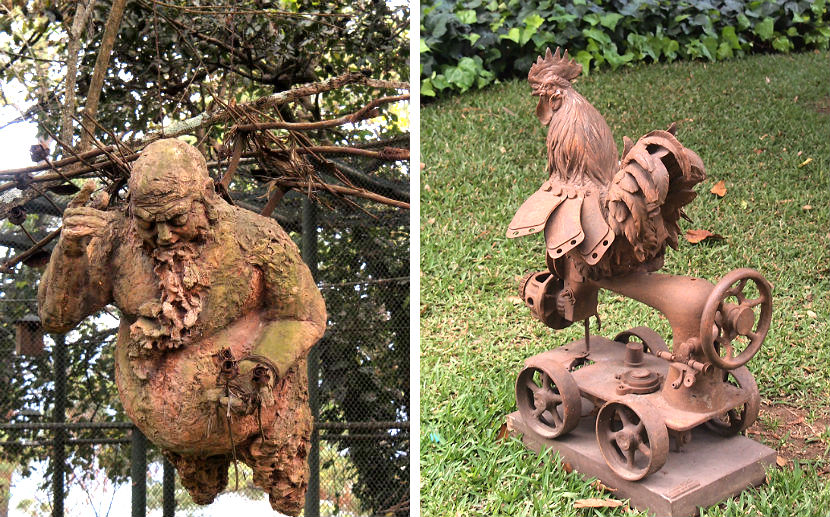We boaded this gorgeous bus in Panajachel (by Lake Atitlán) and headed for Antigua, our final destination in Guatemala. Antigua was once the capital, a well-preserved colonial town that is popular with tourists. It is indeed a beautiful place.
However we were staying a little out of town at a small coffee farm that takes guests. We expected to be in the country, green hills and forests all around. Imagine our surprise when we found ourselves in the dusty, poverty-stricken suburb of San Lorenzo. The street below is perhaps a little shabbier than some in the town, but we were wondering if we were in the right place. But then someone directed us to a high wall, above which we could see greenery. It was our destination, Finca los Nietos (The Grandchildren's Farm), and when we stepped through the gate, we were in another world.
It was the home of Raul Freyre and Christina Keilt, their daughter Grace, and her children Santi and Mati. (Christina and Raul are originally from Maine; the rest of the family, including three more grandchildren, are still there.)
 |
| A street in San Lorenzo |
 |
| Raul with Santi; Christina with Santi and Mati; Grace with Mati |
 |
| An entry to the garden and the main house. |
 |
| Our apartment at Finca Los Nietos: entrance, living room/kitchen, and bedroom, all facing on a shady porch |
 |
| Mati with new cowboy boots on her birthday; a planter made by Christina |
Christina is a stone sculptor, and some of her work is scattered through the gardens at Finca los Nietos. Our favorites were the five planters below, representing her five grandchildren.
Ornamental gardens at Finca los Nietos are lovely, and a small acreage of organically-grown coffee bushes is beyond the gardens.
El Tenedor del Cerro
One day Christina drove us to El Tenedor del Cerro (literally, the fork on the hill), a restaurant and "cultural park" created by the wealthy family that owns Hotel Santo Domingo in Antigua, one of the classiest places in Central America. Although El Tenedor is a restaurant, that is not why we went. There is also an art museum, a modern chapel, children's playground, a zip-line, and above all, gorgeous grounds with spectacular views framing an amazing variety of sculpture.
 |
| View of Antigua from El Tenedor, marred by a couple of tourists |
 |
| Visitors playing on the hill |
 |
| Weekend sales of local crafts at El Tenedor |
There are interesting murals on some of the buildings at El Tenedor, and remarkable sculptures by local artists are scattered all over the extensive grounds.

 |
| The Chapel |
Whimsical animal sculptures, mixed with a couple of real creatures.
Antigua has some of the largest Easter celebrations in the world, including Sunday processions in in Lent. We were in Antigua for the Procession of the Fallen Jesus and Our Lady of Sorrows. It commemorates the moment when Jesus stumbled and fell under the weight of the cross. Streets are packed with tens of thousands of Guatemalans and tourists, all there to witness the spectacle. We were among them.
Hundreds of faithful work throughout the night to create "alfombras" in the streets -- ephemeral carpets made of grasses and plants, flower petals, and colored sawdust. It's a labor of love. The alfombras will be inviolate until the actual procession begins; then they will be scattered under the feat of the worshippers.
In some places the alfombras are adorned with incredible sculptures made of fruit and vegetables.
 |
| Some of flowers are actually peppers and beets! |
 |
| Creatures made of bread. |
As the beginning of the procession nears, roman soldiers appear in the streets. Men in purple are responsible for protecting the alfombras and carrying the floats.
The principal float is huge and heavy; it takes between 75 and 100 men to carry it through the streets.
The other main float, Our Lady of Sorrows, is smaller and is carried by women. Haze in the air is actually clouds of incense.
On one of our last days in Antigua, we went to lunch at Cerro San Cristobal, a hilltop restaurant. Like El Tenedor, the location and views are spectacular. Unlike El Tenedor, there isn't a huge "cultural park," but there are organic gardens, greenhouses, and reasonable prices.
Walking paths and gardens surround Cerro San Cristobal. Organic vegetables and flowers are grown.
 |
| Cerro San Cristobal restaurant |
When it was time to leave, we took a shuttle from Antigua directly to the Guatemala City airport. We didn't want to go into the city itself because of all we hear about the crime. (However Christina, our host at Finca Los Nietos, said that after several years in the country, she has become accustomed to driving into Guatemala City.) In any event, it was a quick flight from there to Mexico City, for the last five nights of our trip.














































































